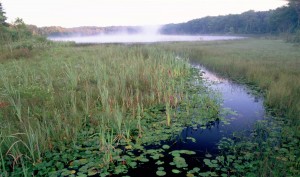
Rising air temperatures and more frequent and extreme rainfall events compound threats to aquatic systems that already exist in urban and suburban settings. These changes threaten to push the Huron River outside of the range of conditions within which the system can support healthy biological communities indicative of a functioning ecosystem.
In response, the Huron River Watershed Council is implementing a suite of strategies to keep water temperatures cool, river flow within the natural range of variation and fish populations healthy. Riparian forests can buffer rivers from increasing air temperatures and also allow water to infiltrate, cool and enter the river as groundwater. These strategies include:
- A Natural Rivers District designation along much of the middle reaches of the river can help maintain these vital buffers. HRWC is working with the State and local governments to strengthen compliance and enforcement of the Natural Rivers District keeping riparian forests intact.
- For fish populations to be resilient to more extreme events such as large rain events or prolonged drought, they need an environment that supports sustainable populations of each age class and high survival of young of the year. To achieve this, HRWC is:
- working with dam operators to reduce damaging high flow events during spawning,
- restoring habitat in highly degraded stretches of river, and
- implementing a “no catch and keep” campaign encouraging fishermen to release caught fish during the spawning season.
This project is funded through the Wildlife Conservation Society’s Climate Adaptation Fund, through the support of the Doris Duke Charitable Foundation.
For more information on the project contact Rebecca Esselman



